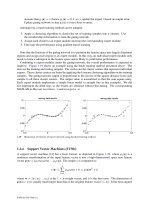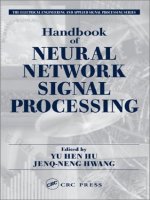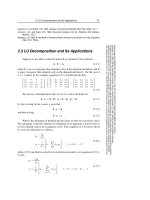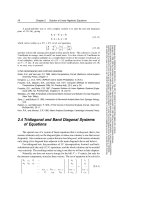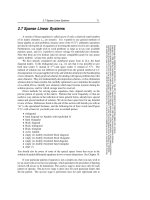Tài liệu Handbook of Technology Management in Public Administration docx
Bạn đang xem bản rút gọn của tài liệu. Xem và tải ngay bản đầy đủ của tài liệu tại đây (13.09 MB, 877 trang )
DK3654—PRELIMS——17/10/2006—15:33—TRGANESH—XML MODEL C–pp. 1–15
DK3654—PRELIMS——17/10/2006—15:33—TRGANESH—XML MODEL C–pp. 1–15
DK3654—PRELIMS——17/10/2006—15:33—TRGANESH—XML MODEL C–pp. 1–15
DK3654—PRELIMS——17/10/2006—15:33—TRGANESH—XML MODEL C–pp. 1–15
DK3654—PRELIMS——17/10/2006—15:33—TRGANESH—XML MODEL C–pp. 1–15
DK3654—PRELIMS——17/10/2006—15:33—TRGANESH—XML MODEL C–pp. 1–15
DK3654—PRELIMS——17/10/2006—15:33—TRGANESH—XML MODEL C–pp. 1–15
Dedication
This book is dedicated to
Stephanie J. Greisler (posthumously)
and
Katherine N. Stupak
With special thanks to the U.S. team of Brenda Adams,
York College of Pennsylvania, and
Julie Spadaro, project editor at Taylor &Francis; and
Doug Barry and Paula Lane at Alden Prepress in the U.K.
DK3654—PRELIMS——17/10/2006—15:34—TRGANESH—XML MODEL C–pp. 1–15
Preface
One day the father of avery wealthy family took his son on atrip to the country with the firm purpose of
having his son develop understanding of how poor people live. He left his son at afarm to spend time
with what would be considered avery poor family. The father retrieved his son afew days later.
On the return trip home the father asked his son, “How was your time on the farm?”
“It was great, Dad.”
“Did you see how poor people live?” the father asked.
“Oh yeah,” said the son.
“So, tell me, what did you learn?” asked the father.
The son answered:
† Isaw that we have one dog that we keep inside; they have four dogs that run through the fields.
† We have apool that reaches to the middle of our garden; they have acreek that has no end.
† We have imported lanterns in our garden; they have the stars at night.
† Our patio reaches to the front yard; they have the whole horizon.
† We have asmall piece of land to live on; they have fields that go beyond our sight.
† We buy our food; they grow theirs.
† We have walls around our property to protect us; they have friends to protect them.
† We have servants who serve us; they serve each other.
Theboy’s father wasspeechless. Then hisson added, “Thanks, Dad, forshowing me howpoorweare.”
—Author Unknown
Isn’t perspective an enlightening and sometimes aparadoxical thing?
Acceptance of technology withoutunderstanding, adoptionwithout analysis,and use without
questioningevincebehaviornot toofar removedfromcultureswhere magicand theoccultare apart
of thefabricofeverydaylife. In that we aresocietiesincreasinglyawashintechnology, having knowl-
edge of thevocabulary, facts, andconceptssurrounding technology is important ;however,wisdom,
discernment, anddialogue regardingthe applications,implications, andramificationsoftechnologyare
vital forcitizenries increasingly experiencing thebyproducts(intended andunintended) of technology.
The disparity between the deep penetration of advanced technology throughout the general
population andthe fundamental lackofunderstanding of theprin ciples andcollateraleffects
emanating from these te chnologi cal resourcesportends apotentiallyvolatile polity.This, in
tandem with burgeoning socio-technical systems, raises import ant public policy questions. Fore-
most among them is the matter of technol ogical determinism. Thespecter of science discovering,
technology directing, and man conforming must be avoided. B.F. Skinneraptly states, “The real
problem is notwhethermachines think but whether men do.”
The nine chaptersofthisbook that follow the introduction are configured to challenge the
reader to consider technology from several perspectives: marketsand the public sector (a macro-
perspective) and organizations, groups, and individual consumers(amicro-perspective).
By engaging this book, the reader will be better able to face the challenges posed by the con-
cluding article “OrganizationalPassages” (Stupak and Martin).
May our praxis abilities be buoyed, may the quality of ourthought be richer, and may our
inquiry into contemporarytechnological issues be enhanced through thistext.
Once upon atime we were just plain people. But that was before we began having relationships with
mechanical systems. Get involved with amachine and sooner or later you are reduced to afactor.
—Ellen Goodman, “The Human Factor,” The Washington Post ,January 1987
Peace.
DK3654—PRELIMS——17/10/2006—15:34—TRGANESH—XML MODEL C–pp. 1–15
Editors
David Greisler, DPA (dgreisle@y cp.edu) is AssistantProfessor of Busine ss at York College of
Pennsylvania. Teaching operations management and business strategy in both the undergraduate
and graduate programs, Dr.Greisleralso does focused consulting in both service and manufac-
turing settings emphasizing process improvement, organizational assessment,strategicplanning,
and executive coaching.
Priortojoining York College in the Fall of 2002, David S. Greisler spent twenty-two years
in the healthcare industry. Fifteenofthose yearswere with WellSpan Health, an integrated
healthcare deliverysystem serving southcentral Pennsylvania. In his last five yearswith Well-
Span he servedasChief Opera ting Officer of WellSpanMedical Group, a235-physician
multispecialty group practice. Th eMedical Group has 51 office locations in York and Adams
counties.
Dr. Greisler holds an undergraduate degreefrom Johns Hopk ins University, aMaster in
Health Service Administration from George Washington University, aMaster in Public Admin-
istration from the University of Southern California, and aDoctorate in Public Administration
from the University of Southern California.In1997 he was appointed Senior Academic Fellow
at Mount Vernon College in Washington, D.C. As the primary author of morethan 50 pro-
fessionalpublications, Dave haspresented hiswritings at bothnationaland in ternational
conferences.
Dr.Greisler’s li fe is made complete throughhis faithinChristand thejoy of raisinghis
six-year-old son Luke.
RonaldJ.Stupak, PhD () is arecognized authorityonorganizations
undergoing major change.Hewas atenured Senior Professor of organizational behavior in the
School of Public Administration at the University of Southern California, an executive, aline
manager,and apublic servant. In 1994, while at USC, he was alsoappointed the 1994 Distin-
guished Scholar in Residence at the National Centerfor State CourtsinWilliamsburg, Virginia.
Earlier, in his career as afederal executive, he helped to establish the Federal ExecutiveInstitute
(FEI)inCharlottesville,Virginia.In1996 he received theWarrenE.BurgerAward forhis
outstanding contributions to co urtmanagementand judicial leadership.Finally,hereceived
outstanding teaching awards at Miami University, USC,and the FEI.
His reputationasatheorist and aprac titioner is clearlyillustrated by the following biograph-
ical data: He has been on the editorial boards of the Public Administration Review,the Journal
of Urban Affairs,the JusticeSystem Journal, The Public Manager,and served as Editor-in-Chief
of The Federal Management Journal from 1987 to 1990. Currently, he is Co-Editor-in-Chief of
the JournalofPowerand Ethics and on the Editorial Boards of the Journa lofManagement
History and Public Administration andManagement. He has written over 175 books and articles
on awide range of issues including domestic and foreign policy, public administration, politics,
organizational excellence,executive development, and strategic planning.Inaddition, Stupak
hasserved as aconsultant forhundredsoforganizations, includingthe FederalBureau of
Prisons, Hewlet t-Packard, the Federal Emergency Management Agency, the Central Intelligence
Agency, Johnson&Johnson, the Supreme Courts of Wisconsin and New Jersey, the U.S. Marine
Corps, theYorkHealthSystem, York,Pennsylvania, andthe Anne ArundelHealth
System,Annapolis,Maryland.Clearly,hehas been active at the“cuttingedge” of
public/private partnerships and the changing workforce as evidencedinhis numerous consul-
tations andpublications in theareas of workforceimprovement,employeeproductivity,
leadership performance, and customer satisfaction.
DK3654—PRELIMS——17/10/2006—15:34—TRGANESH—XML MODEL C–pp. 1–15
Stupakreceived his BA (Summa cum Laude) from Moravian College, his MA in and PhD
from Th eOhio StateUniversity and in 1998 was awardedanHonoraryDegree of Doctor of Laws
from MoravianCollege.
In thepast decade, he hasfocused on private consulting, becoming active andcritically
involved in several new areasofinterest: leadership development, transitions in family businesses,
the organizational impact of changesinhealth care, and executive coaching.
DK3654—PRELIMS——17/10/2006—15:34—TRGANESH—XML MODEL C–pp. 1–15
Table of Contents
Chapter 1 Introduction 1
Chapter 2 TheCulture of Technology: Savants, Context, and Perspectives 13
Chapter 3 Public Sector PerspectivesonTechnology. 35
Chapter 4 Technology Transfer:Innovations, Concerns, and Barriers 219
Chapter 5 Ethical Issues and Concerns 275
Chapter 6 Managing Change and Measuring Performance 401
Chapter 7 Technology’s ContributiontoQuality 529
Chapter 8 National Security Issues 573
Chapter 9 Negotiating Technology Issues 665
Chapter 10 Technology and the Professions 771
Index 845
DK3654—PRELIMS——17/10/2006—15:34—TRGANESH—XML MODEL C–pp. 1–15
1
Introduction
CONTENTS
Science Versus Technology 2
What Is Technology? 2
Who Is in Charge:Man or Machine? 4
Understanding Technology 5
Ethical Considerations 6
Technology: Buy It Once—Own It Forever 7
Cheap Speed 8
ElectronicsTechnology: The Great Enabler 8
Adaptation, Forecasting, and Opportunity 9
Trading Technology for Political Goals 10
The Nex tRevolution: Nanotechnology and Biotechnology 11
Managing Change: Therein Lies the Rub 12
People are the quintessential element in all technology. .Once we recognize the inescapable human
nexus of all technology our attitude toward the reliability problem is fundamentally changed.
Garrett Hardin, Skeptic,July–August 1976
It is not enough that you should understand about applied science in order that your work may increase
man’sblessings.Concern forman himselfand hisfatemustalwaysformthe chiefinterestofall
technical endeavors, concern for the great unsolved problems of organization of labor and the distri-
bution of goods —inorder that the creations of our mind shall be ablessing and not acurse to mankind.
Never forget this in the midst of your diagrams and equations.
Albert Einstein, in an address at Cal Tech, 1931
In isolation, technology is avalue-free commodity. Yet it is also the principal tool that enables
humans to determinetheir destiny. Technology has evolved beyond amere set of tools to assist
the human race to build, travel,communicate,cure itself, or annihilateitself many times over.
Technological tools have progressed to the point where the accumulation, storage,and manipu-
lation of massive data may soon cross the threshold into knowledge. Knowledge,inturn, bestows
unparalleled power on thosecapable of effectivelywielding it.
The ability to create technology is asingular giftentrusted only to humans. This gift manifests
itself in the creation of machines and creative techniques that amplify mental and physical capa-
bilities. Technology multiplies the ability to do work, accomplish more complex goals, explore
and understand the physical universe,and overcom ethe challenges, obstacles, and threats of the
DK3654—CHAPTER 1—3/10/2006—14:50—SRIDHAR—XML MODEL B–pp. 1–12
1
day. Indeed,thisapplication of practicalcre ative genius offers thepotential forindividual
self-fulfillment, empowerment, andhappiness.However,technologicalmarvels andubiqu itous
tools of convenience bring adisquieting overdependence and vulnerability to disruption, crimi-
nality, abuse, and mismanagement, as well as physical and spiritual isolation. Herein lies the true
challenge—to develop management skills commensurate with the physical capabilities afforded by
the continuousevolution of technolo gy. Can we marshalthe necessaryforesight and management
acumen to derive the maximum benefit from these new tools? Or will their latent potential to
improve thehuman condition remainunrealized? Whileitiscertainthatwewillcontinue to
shape and applytechnology to our daily needs, it is equally certainthat we will also fall short of
extracting technology’sfullpotential.
From amanagement perspective, complacency,arrogance, and simplelaziness will continue to
be human obstacles to be overcome or mitigated. The perpetuallag in the development of analytical
methods,auditable decision-making processes, and legal protections will continue to inhibitthe
ability, for example, to take maximum advantage of the information-processing capabil ities that
are continually advancing. Striving to perfect the humanside of the equation in the management
andimplementation of technologicaltools will co ntinue forthe foreseeablefuture. Whileour
impressive array of tools allowsustotackle larger and more complex problems, it also enables
us to make bigger, more far reaching, and more dangerous mistakes.
Theapplication and management of technology mold anation’s social, political, economic,
educational, medical, andmilitaryinterests.For many years, analysts have examined specific
technologies—basic andapplied,civil andmilitary—in assessingtheir impactuponweapons
systemsand commercial systems alike. Many studies have purportedtoreveal the negativeconse-
quencesoftechnological growth upon theenvironment. Most such studiessha re amorbid
Malthusian tone of hopeless foreboding in which mankind will suffer from mass starvation, cata-
strophicclimate change,and all manner of unavoidablevictimization. Although theseanalyses
provide entertaining reading and even occasional insight into the global technology outlook, they
do not accuratelyelucidate the future of globa ltechnological growth,capture its inherent uncer-
tainties, or assess its impact on the four key elements of nationalpower—society, politics,the
military, and the economy.
This hand book addresses themanagement, implementation, andintegrationoftechnology
across awide varietyofdisciplines while highlighting the lessons learned along the way.
SCIENCE VERSUS TECHNOLOGY
Technology is adifficult term to pin down into auniversally accepteddefinition. So much of what is
interpreted as “technology” represents impressionistic categories peculiar to broad fields of human
activity. However, beforedelving into the diverse definitions of “technology,” it is important to
address the larger issue of the differencesbetween “science” and “technology.”
Much confusionreigns concerning boundaries within the intertwining relationship between
science and technology. These two fields coexist in the space known as “applied science.” This
coexistence, however,ishighly complex, and the area is very gray and indistinct. Rather than
simplystate that technology picks up where science ends or one of hundreds of other imprecise
adages, it is more useful to draw effectivedistinctions betweenthe two by highlighting their most
fundamental differences(Table 1.1).
W HAT I S T ECHNOLOGY?
Now that we have arrayed som eofthe differencesbetweenscience and technology we can proceed
to explore the diversity of views regarding whattechnology is. As revealed in Table 1.2,nosingle
or unified definition of “technology” exists across the professions. Table 1.2 offers arepresentative
sample of useful definitions created by reputableorganizations. It is up to readers to choose the
mostuseful construct for their field of activity.
Handbook of Technology Management in Public Administration2
DK3654—CHAPTER 1—3/10/2006—14:50—SRIDHAR—XML MODEL B–pp. 1–12
TABLE 1.1
ScienceVersus Technology
Science Technology
Goal: The pursuit of knowledgeand understanding for its
own sake
Goal: The creation of artifacts and systems to meet
people’s needs
Corresponding scientific processes Key technological processes
Discovery (controlledbyexperimentation) Design, invention,and production
Analysis, generalization, and creation of theories Analysis and synthesis of design
Reductionism,involving the isolation and definition of
distinct concepts
Holism, involvingthe integration of many
competing demands, theories, data, and ideas
Making virtually value-free statements Activities always value-laden
The search for and theorizing about cause (e.g., gravity,
electromagnetism)
The search for and theorizing about new processes
(e.g., control, information)
Pursuit of accuracy in modeling Pursuit of sufficient accuracy in modeling to
achieve success
Drawing correct conclusions based on good theories and
accurate data
Making good decisionsbased on incompletedata
and approximate models
Experimental and logical skills Design, construction,testing, planning, quality
assurance, problem-solving, decision-making,
interpersonal, and communication skills
Using predictions that turn out to be incorrect to falsify or
improvethe theories or data on which they were based
Trying to ensure, by subsequent action, that even
poor decisions turn out to be successful
TABLE 1.2
Selected Definitions of “Technology”
The application of scientific advances to benefit humanity www.sln.fi.edu/franklin/glossary.html
Applicationofknowledgetodevelop tools, materials, techniques,
and systems to help people meet and fulfill their needs
www.user.mc.net/~kwentz/eduspeak.html
In education, abranch of knowledge based on the development and
implementation of computers, software, and other technical tools,
and the assessment and evaluation of students’ educational
outcomesresulting from their use of technology tools
www.ncrel.org/sdrs/areas/misc/glossary.htm
1. Human innovationinaction that involves the generation of
knowledgeand processes to develop systems that solve problems
and extend human capabilities. 2. The innovation, change, or
modification of the natural environment to satisfy perceived
human needs and wants
www.iteawww.org/TAA/Glossary.htm
The application of science to the arts. The advances in theoretical
knowledge, tools, and equipment that drive industry
www.bloomington.in.us/hoosiernet/CALL/
telecommunity_94/glossary.html
The application of science and engineeringtothe development of
machines and procedures in order to enhance the human condition
or to improve human efficiency in some respect
www.dsea.com/glossary/html/glossary2.html
The practical application of science to commerce or industry www.cogsci.princeton.edu/cgi-bin/webwn
Electronic media (such as video, computers, compact discs, lasers,
audio tape, satellite equipment) used as tools to create, learn,
explain, document, analyze, or present artistic work or information
www.ncpublicschools.org/curriculum/ArtsEd/
vglossar.htm
(Continued)
Introduction 3
DK3654—CHAPTER 1—3/10/2006—14:50—SRIDHAR—XML MODEL B–pp. 1–12
W HO I SIN C HARGE:MAN OR M ACHINE?
“Science discovers, Technologymakes,Man conforms.”—Thissentimentwas captured as the
motto of the 1933 Chicago Century of Progress Exposition and expresses an important but over-
stated fear that the technology mankind creates will rulehis destiny.This concept, broadly known
as technological determinism, argues that societyisforced to adjust to its machinery rather than
makeits machin ery conform to human purposes. Some scholars, such as Jacques Ellul and Lewis
Mumford, have even calledfor resistancetoautonomous technology, for the restoration of human
agency. While apopular theme in science fiction, the day of mankind’s subordination to machinery
showsnosigns of arriving.
TABLE 1.2 (Continued)
In the context of export control, technical data, technical information,
technical knowledge, or technical assistance. Any specific
information and know-how (whether in tangible form, such as
models, prototypes, drawings, sketches, diagrams, blueprints,
manuals,software, or in intangible form, such as training or
technical services) that is required for the development,
production, or use of agood, but not the good itself
www.llnl.gov/expcon/gloss.html
and www.exportcontrols.org/glossary.html
Literally, “the study of methods”; equally, the study of skills. Often
erroneously described as “applied science” (and thus assumed to
be dependent on science for its theories), technology in practice
develops empirically, frequently resolving tasks and dealing with
exceptionsand paradoxes via methods that are known to work
without knowing, scientifically, just how they work. In this sense,
much of science is better understood as “codified technology,” the
summation of skills in practice: it can be worked consistently, but
we still cannot reduce it to aconsistent system of order
www.tomgraves.com.au/index.php
The methods of application of an art or science as opposed to mere
knowledgeofthe science or art itself
www.scientology.org/wis/wisger/gloss.htm
The production of goods and services that mankind considers useful.
Technology is not the same as science, though in today’s society
the two are closely linked. Many of our products—our computers,
our plastics, our medicines—are direct products of our knowledge
of the behavior of atoms and molecules. However, it is not
necessary to understand the science in order to make use of
technology. Long before the chemistry of steel was understood,
mankind knew how to make abetter sword
www.sasked.gov.sk.ca/docs/chemistry/
mission2mars/contents/glossary/t.htm
The practical application of knowledge, especially in aparticular area
such as engineering. Acapability given by the practical application
of knowledge. Amanner of accomplishing atask, especially using
technical processes, methods, or knowledge. The specialized
aspects of aparticular field of endeavor
www.projectauditors.com/Dictionary/T.html
The practical application of knowledge, especially in aparticular area www.i-c-s-inc.com/glossary.htm
Applied science, i.e., natural science and the scientific method
applied to solving practical problems. It usually considers at least
the potential for commercial exploitation
www.beta-rubicon.com/Definitions.htm
The practice,description, and terminology of any or all of the applied
sciences that have practical value and/or industrial use
www.unistates.com/rmt/explained/glossary/
rmtglossaryt.html
Handbook of Technology Management in Public Administration4
DK3654—CHAPTER 1—3/10/2006—14:50—SRIDHAR—XML MODEL B–pp. 1–12
Those who sound the determinist calloften argue that military technology has twisted the
relationship between man and machin etothe point where societyhas reshaped itself expressly
to facilitatethe creation of technological marvelsofwarfare. Some have asserted that during the
Cold War the U.S. conceded commercial marketstothe Germans and Japanese because high levels
of Pentagon spending siphoned off“large numbers of engineers, physicists, mathematicians and
other scientists from export industriesinto defense related fields.”
An important counterargument holds that technology is not autonomous or deterministic at all
but social ly constructed, driven by social, economic, and politicalforces that are humaninorigin
and thus subject to humancontrol.Certainly supporting this view would be the semiconductor and
related computer industries. Once driven primarily by the voraciousneeds of the defense sector for
ever more rapid and sophisticated computational and designpower, the civilian side of the industry
is now in the driver’s seat with the muchlarger commercial sector driving demand and research
agendas. The defense sector has largely been relegated to the roleofconsumer and follower of
industrycapabilities.
UNDERSTANDING TECHNOLOGY
Is technology an irresistible force? Is it aforce for positive change? Must it be accepted wholesale,
or is it subject to anatural selection process where humans consciously or unconsciously filter
technology by regulating and controlling the aperture through which it mustpass before finding
acceptance in daily humanlife? And once it passes through thesegates and finds acceptance, is it
actuallyunderstood by the generalpopulation? Does the population possessavocabulary that
indicates morethan apassing familiarity with these new technol ogies? Or are these applications
acceptedasmere “tools” with little additional significance?
It is important for acitizenry awash in technology and the byproducts of science to have some
knowledge of their basic facts, concepts, and vocabulary. Certainly, those who possess such knowl-
edge have an easier time following newsreports and participating in public discourse on science
and technology. Curiously, the disparity betweenthe deep penetration of advanced technology
throughout the general population and the fundamental lackofunderstanding of the princi ples
underlying the tools the public wields points to the presence of arather large sub-class that can be
termed “technical idiot savants.”
Technicalidiot savants comprise technologyusers; technicianswithout depth; “six-month
experts”withgrandiosetitles such as “CertifiedNetwork Engineer” or “Certified Web Designer”
createdbycertificate-granting proprietary programs; help-desk workers who are just one step ahead
of the clients they serve; and “the rest of us”—the end-userswho are able to use cannedprogramsto
do their jobs but have no inkling of how they operate or whattodowhen something goes wrong.
The compartmentalization of technical knowledge and skills is akey characteristic of the rise to
prominence of technical idiotsavants within our society.
Much has been written over the past several decades on the “inevitability” that the techno-
logical revolutionwill transform international,interpersonal, andbusinessrelations.
Contemporaryclaimstothat effect are just thelatest to argue that technologicalchange has
profound effectsonhuman andsocietal relations. In fact, theoverwhelmingtheme in the
social and scientific literature supports these presumptions. But are the effects of technological
changeasfar reaching as the li terature suggests, and do they penet ratevery deeplyintothe
general culture, its organizations, or the psyche of its citizens? And where does the educational
system enter into the process of understandingthe roleoftechnology in the physical world and
day-to-day existence?
Intuitively, one could reasonablyconclude that those living in aperiod of rapid change would
have an intimateunderstandingofthose forces. After all, historians and archaeologists often portray
ancient cultures in such an idealized manner. Apresumption often underlying their studies is that all
Introduction 5
DK3654—CHAPTER 1—3/10/2006—14:50—SRIDHAR—XML MODEL B–pp. 1–12
elements of the group, tribe, or civilization were aware of, or at least affected by, the technology
of the time. Whileitisavirtualcertaint ythatliving conditions andpatterns of activity were
influencedbythe contemporary state of technologicaldevelopment, it is by no mean scertain
that all members of those societies understood the technology available to them or its underlying
scientific basis. In alllikelihood, they simply used technology as atoolwithout giving it
muchthought.
Acceptance without understanding,adoption without analysis, and use without questioning
evince behavior not too far removed from cultures where magic and the occultare part of the
fabric of everyday life. The assumption that aubiquitous system impenetrable to casualunder-
standing will be accepted as fact relatestothe tw enty-first-centurywillingness to follow
technology’s leadwith little thought as to where it will go or what reallygoes on in that black
box on the desk.
It is thislack of transparency—an impenetrable mystery to most—and ashift away from the
mechanical replication of man’s labors to the mimicking of his thought process that createsaclimate
for ready acceptance in spite of ageneralizedbewildermentover how the technologyworks. Such a
reality forces the next question: Is it important to understand atechnology so broadly and readily
accepted and applied throughout the population? The answer is an unequivocal yes.
ETHICAL CONSIDERATIONS
Inseparable from the importanceoftechnical literacy and abasic understandingofthe tools of the
dayare questionsofresponsibilityonthe part of both governmentand technologyholders to
adequately and accuratelyinform the public of the intricacies and conse quencesoftechnological
advancements upon social policy.
Thecurrent debate over humanembryonic stem cell researchmarks acontemporary case in
point.The moral dile mmasand issues posed by therecentlyevolved technological abilityof
scientists and technicians to effectively clone humanstemcells in the hope of developing new
therapeutic approaches to several fatal or debilitating health conditions are quite profound. Stake-
holders in this debate fall into the four general camps described in Table 1.3.
Unfortunately, this debate is characterizedbyhyperbole,misinformation, and overstated claims
by individuals and groups with much to gain or lose by its outcome.The intrinsicsocietal weakness
pointed outbythis increasingly politicized debate is the lack of an impartial arbitercapable of
providing an accurate, believable, and understandable overview of this technology-enabled avenue
of biomedicalresearch.
TABLE 1.3
Stem Cell DebateStakeholders
Camps Motivation
Victims groups Desperatelyseeking miracle cures
Researchers and the pharmaceutical
industry
Seeking new therapeutic approaches and potentially large profits
Moderate decision-makers Attempting to balance moral questions against uncharted scientific ground
and overstated potential
Religious groups Expressing concerns over sanctioning euthanasia-likeprograms
Handbook of Technology Management in Public Administration6
DK3654—CHAPTER 1—3/10/2006—14:50—SRIDHAR—XML MODEL B–pp. 1–12
T ECHNOLOGY:BUY I T O NCE—OWN I T F OREVER
The technology investment choices facing business and government often entail long-term conse-
quences. Life-cycle costs vary widelydepending upon the application, scale of investment, and
mission criticality of the technology chosen. The most extreme exampleofbeing wedded to an
early technology choice is the military. As depicted in Figure 1.1,the long life cycles of military
products are routinely measured in yearsfor sensors and countermeasures, decades for small arms,
scores and half-centuries for ships, and in the case of the B-52, acentury for aircraft.
SCIENCE
Basic Science
Applied Science
Theoretical Science
Develop
fundamental
principles
Experimental Science
Verify
fundamental
principles
Fundamental Themes
Develop
applications-oriented principles
Experimental Themes
Demonstrate
functions and
testbeds
Engineering Principles
Product Engineering
Analytical Methods
Math and science
of engineering design
and applications
Technologies
Future technologies,products,
design/analysis/verification
tools.Etc.
Exploratory
Development
Develop next generation product
functionality &applications
testbeds
Product
Development
Develop cost-effective, high
reliability,and competitive
products
ENGINEERING
FIGURE 1.1 Boundaries between engineering and science. Published by the Stevens Institute of Technology,
it is auseful visualization of how science, applied science, and engineering interact.
Introduction 7
DK3654—CHAPTER 1—3/10/2006—14:50—SRIDHAR—XML MODEL B–pp. 1–12
C HEAP S PEED
Despite warnings from some that Moore’s law may be reachingits theoretical limits, so far silicon
chip technology has continuedtoadvance at afurious pace, with processing powerincreasing
exponentially even as the cost per transistor continues to shrink (see Figure1.2).
Such long-term commitments to aparticular technological design are usually not anticipated at
aprogram’s inception. It was never imagined by the designers of the B-52 in 1946, for example, that
their creation would still be in active service in 2004 or that its life would be extended until at least
2040. Compared with the life cycle of large military systems, electronicsubsystems and consumer
or office products experience rapid change and turnover.
ELECTRONICS TECHNOLOGY: THE GREATENABLER
No single technologyexperiences morerapid, steady,and predictable pa tternsofchangethan
microelectronics.Intel co-founderGordon Moorepredicted in 1965 that thesemic onductor
industry would be able to double the number of transistors on asingle microprocessor every18–
24 months, resulting in arapid turnover in generations of microcircuits. As the number of transis-
tors doubles, so does processing speed, which in turn increases the powerofcomputer systems in
which the transistors are embedded (see Figure1.3).
94+Years
86+Years
79+Years
51+ Ye ars
100
KC-135
C-130
B-52
F-15
2040+
2040+
2030+
2021+
1961
1973
1965
1957
1957
1946
1969
1954
FIGURE 1.2 Longevity of military aircraft.
TRANSISTORS PER CHIP
100,000,000
10,000,000
1,000,000
100,000
10,000
1,000
100
10
1
'00
Source: Intel
'70 '80 '90
AVERAGE TRANSISTOR PRICE
$1.00
0.10
0.01
0.001
0.0001
0.00001
0.000001
0.0000001
'70 '00
'80 '90
FIGURE 1.3
Handbook of Technology Management in Public Administration8
DK3654—CHAPTER 1—3/10/2006—14:50—SRIDHAR—XML MODEL B–pp. 1–12
